Greyhound Racing Victoria (GRV) recommends that greyhounds undertake at least a 28-day winddown period from all race related activities to give the greyhound the best chance to successfully transition into a pet life. While this is the minimum wind-down period required for a greyhound to be accepted into GRV’s Greyhound Adoption Program (GAP), preparation for re-homing will ideally take at least eight weeks.
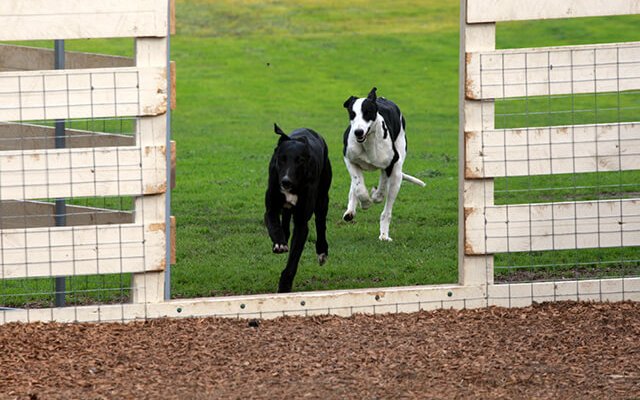
Local Rule 42.6 also requires greyhounds undertake a 28-day wind-down period before an owner can consider euthanasia (unless the greyhound is suffering from a serious medical condition). Please note that a greyhound can be re-homed at any time during the wind-down period if a suitable home is found. It is however recommended that the new owner be informed that the greyhound has not undertaken a full wind-down period. Please see the Post Adoption Care Guide – New Owner. This guide should be complete and provided to the new owner on adoption.
It is important to strive for a successful adoption from the beginning and the key to success is offering as much information as possible. This allows the adopter to clearly understand what their new greyhound might be like and what they will need during the transition to pet life.
HOUSING
During a wind-down period, greyhounds should be provided with at least 15 square metres of housing area (preferably some of it grassed) to allow for self-exercise and play during the day. This will provide the greyhound with the opportunity to get used to larger spaces that are similar to those they will experience in a new home as a pet.
FEEDING AND WEIGHT
During the wind-down period the greyhound’s diet should be adjusted to allow some weight gain over and above its optimal racing weight. The amount of weight gain will vary depending on the individual greyhound; but will be on average at least two kilograms. You should speak to your veterinarian for guidance or if you have any concerns.
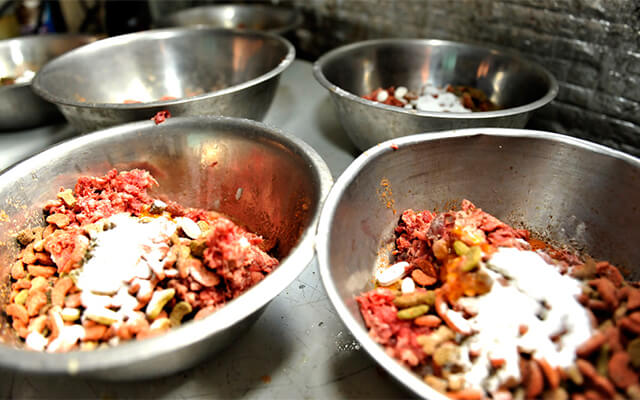
VETERINARY CHECK AND DE-SEXING
To prepare your greyhound for re-homing, a veterinary check should be undertaken to identify any racing injuries or health conditions that require short or long-term treatment. Their teeth should be cleaned and nails trimmed. The greyhound should also have a current C5 vaccination, and up-to-date parasite treatment.
It is highly recommended that your greyhound is de-sexed as soon as possible after the decision to retire has been made, and prior to re-homing. De-sexed dogs living in the community cost significantly less to register with local council and some local councils have mandatory de-sexing orders in place which means the greyhound could not be registered until it is de-sexed. In addition, evidence shows de-sexing can reduce a greyhound’s tendency to show undesirable behaviours; such as, being overly boisterous and low-level aggression towards other dogs. De-sexing also has important health benefits including a reduced chance of developing reproductive cancers and other diseases, and in male dogs, prostate issues.
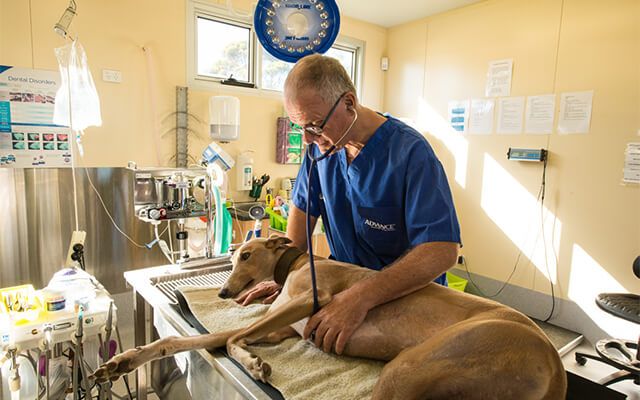
Developing pet life skills in your greyhound
Pet life skill training is about teaching your greyhound how to relax and positively engage with the environments, people, animals and sounds that they will encounter as a pet. These encounters are often new and can be a little overwhelming for your greyhound at first. It is important that all experiences are provided in as positive a manner as possible and at a pace that your greyhound is comfortable with. This pace will depend on the individual greyhound. Repeated exposure to situations which may cause stress, fear or aggression may make your greyhound’s behaviour worse.
EXERCISE AND SOCIALISATION
Exercise remains an important part of a greyhound’s life during the wind-down period and preparation for re-homing. During the wind-down period, exercise should be slowly decreased.
Socialisation is about getting your greyhound used to life in a family. Life in a family involves interactions with a small or large number of people, dogs, of all sizes, cats and other animals, loud noises and multiple noise sources. Pet dogs also often spend time on their own, without humans or other dogs for company, while most greyhounds will have been in the company of other greyhounds during their racing life.
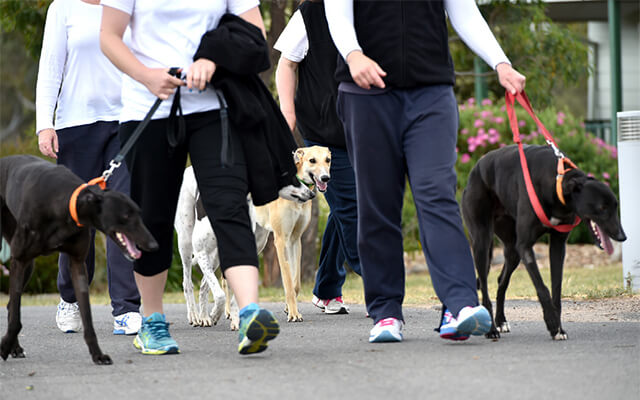
Your greyhound should have a minimum of 60 minutes exercise and socialisation daily. This could consist of combinations of the following activities:
- gentle exercise daily in an area containing natural daylight;
- walking on a leash;
- exposure to people through handling and play;
- exposure to different environmental stimuli, such as rope toys, squeaky toys, rubber toys, chew/food toys, bones etc
Other great socialisation activities include:
- exposure to different flooring surfaces, such as carpet, concrete, tiles, wood floors, bricks and stairs;
- exposure to people in a non-training/racing setting, such as play time or professional obedience training;
- travelling inside a car (properly secured) as opposed to in a dog trailer;
- exposure to small dogs and other larger dogs (the greyhound should be muzzled, on leash and under the control of a responsible adult at all times with the interaction immediately ceased if the greyhound shows signs of predatory or aggressive behaviour including barking, lunging, growling, snapping and stalking).
Remember, if you are exposing a greyhound to other dogs, animals and young children, this should be in a controlled environment and in as positive a way as possible, and the greyhound should be muzzled
NOISES
Initially exposure to noises should be done in an environment where your greyhound feels safe and secure. It may be useful to play noise exposure CDs to greyhounds in a kennel environment, or to expose your greyhound to sounds and noises from the safety of a crate. However, if your greyhound has never been crated, you will need to spend some time training them to feel comfortable and safe in the crate. If your greyhound shows signs of distress when exposed to unfamiliar noises, please contact a pet dog trainer for advice.
ISOLATION
Most pet dogs experience periods of isolation from humans or other animals. To determine how well your greyhound copes with isolation, you should slowly introduce them to short, positive periods of isolation increasing to longer times (2-3 hours) if they are coping well. If at any time your greyhound becomes distressed or appears to be putting itself in danger, you should stop the isolation exercises and seek help to develop a training plan for this behaviour.
Begin with 10-20 minutes’ isolation from humans and other animals daily with toys or food rewards, if the greyhound appears to be coping well increase to 40-60 minutes every second day with toys or food rewards, gradually increasing to 2-3 hours.
HANDLING AND BASIC PET SKILLS
Handling is about providing your greyhound with positive interactions with humans and other animals in a controlled environment. Only allow your leashed and muzzled greyhound to meet new animals or people when they are calm and relaxed and can approach on a loose leash. If your greyhound shows signs of predatory or aggressive behaviour including barking, lunging, growling, snapping, stalking, or signs of distress such as withdrawal or avoidance, you should immediately remove them from the area and seek help from an expert (animal/veterinary behaviourist or qualified dog trainer).
Most greyhounds will have learned basic handling and pet skills well before retirement; such as appropriate toilet training. If your greyhound has not been toilet trained, this training should occur during the wind-down period. Further pet skills that your greyhound should be taught include:
- staying calm when washed;
- not jumping up on people;
- not to push through doors;
- learning to come when called.
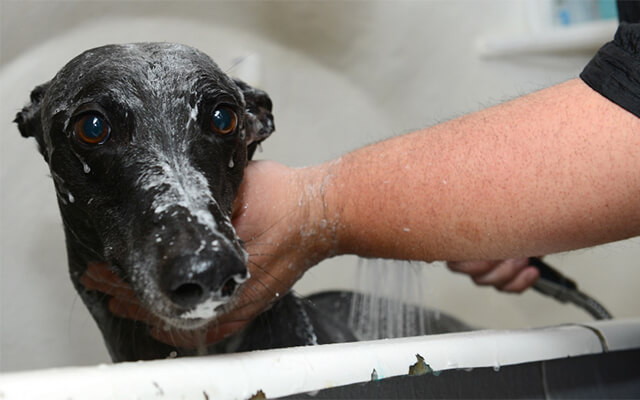
If you require any advice on how to best teach your greyhound pet skills, you are welcome to contact GAP on
03 5799 0166 for information.


